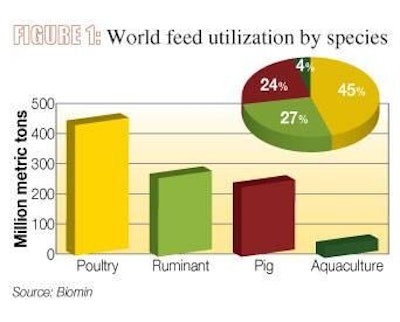
It is not surprising mycotoxins continue to be found at high levels once again in the 2013 grains harvest. As worldwide demand for animal-based products continues to grow, demand for high-quality feed will also increase. Despite increasing awareness of the problems caused by mycotoxins, the impact that these toxic substances have on the animal industry has not yet been fully understood.
An overview of the world feed market
According to the International Feed Industry Federation (IFIF), world compound feed production is approaching 1 billion tons/year. Feed manufacturing generates a turnover of approximately more than US$370 billion/year. The poultry feed industry comprises 45 percent of the total market, followed by the ruminant and pig industries at 27 percent and 24 percent, respectively. Aquaculture is a growing market, which represents 4 percent of total feed.
Asia is the largest producing region and covers 38 percent of the global market with a total of 356 million tons of feed per year. The largest overall feed producer is China, followed by the United States, Brazil, EU and India.
Some of the most important commodities used in animal feed are energy-rich maize and wheat. In many parts of Asia, rice has also become one of the main ingredients. The leading plant protein source used worldwide is soybean as it contains 40-48 percent of crude protein and has a good balance of essential amino acids to compliment a cereal-based diet. Due to rising prices for conventional commodities, the animal industry has turned to the use of dried distillers grains with solubles (DDGS). DDGS is a nutritious substitute which provides high amounts of both energy and protein at low costs.
Despite control strategies mycotoxins remain a global issue
Testing feed components or finished feed for mycotoxin content is a routine practice in many parts of the world. However, the main concern observed by the IFIF is that out of the 1 billion tons of feed produced worldwide, around 300 million tons are produced in farms that mix their own compound feed and do not regularly test the raw materials used on a regular basis for possible human and animal health hazards, such as mycotoxins.
The latest BIOMIN Mycotoxin Survey focuses on some of the main global feed commodities (corn, wheat, soybean, rice and DDGS) analyzed between January and September. The most common mycotoxins in animal feed are produced by Aspergillus, Fusarium and Penicillium species, and include aflatoxins (Afla), zearalenone (ZEN), deoxynivalenol (DON), fumonisins (FUM) and ochratoxin A (OTA). Mycotoxin levels were found to be above the detection limits in 73 percent of all samples tested. The highest concentration of Alfa (89 ppb on average) was observed in U.S. maize samples. At 89 ppb, Afla poses a medium risk for pigs and poultry, yet a very high risk for dairy cows. FUM levels were also highest in North American maize with a concentration of over 6,000 ppb, a level that can affect all types of livestock.
In China, the highest DON levels overall were observed in wheat at over 1,800 ppb, a concentration level that has a high impact on pigs and poultry. ZEN levels in Asia were also highest in maize samples and were calculated at 350 ppb. At high concentrations, ZEN is a high risk factor especially for pigs, but can also affect the performance of breeders and layers. The global values for OTA were relatively low in samples from 2013.
Mycotoxins affect profits
Feed is the most important component in animal production and can represent up to 70 percent of total costs. Producing high-quality feed is an indispensable but challenging task due to the unavoidable contamination of grains with mycotoxins.
The effects of mycotoxins in the animal depend on several parameters such as age, physiological state, nutrition, and the type and quantity of mycotoxin uptake. Ingestion of these toxic compounds does not always lead to visual symptoms, which makes the problem very difficult to detect. Animals fed a mycotoxin-contaminated diet have reduced immune responses due to an alteration of the normal immune system, which leads to immunosuppression. Fungal toxins have been shown to decrease the resistance of the animal to many pathogens, resulting in higher susceptibility to diseases. They can also affect the animal's response to vaccination programs, leading to reduced antibody titers.
Aflatoxins target primarily the liver and have carcinogenic effects on animals. The highest sensitivity is observed in dairy cows, which metabolize aflatoxin B1 to aflatoxin M1, a metabolite found in the milk. Animals ingesting zearalenone exhibit various symptoms related to the reproductive system. Sows are known to have the highest sensitivity to ZEN due to its estrogenic effects. Deoxynivalenol inhibits protein synthesis and leads to feed refusal, especially in piglets, which results in reduced weight gain. Fumonisins interfere with the sphingolipid metabolism leading to cell membrane damage that can affect the liver, kidney, brain and also the nervous system. The highest sensitivity to FUM is observed in pigs. Ochratoxins are carcinogenic and nephrotoxic compounds which greatly affect poultry, particularly layers and breeders.
The ingestion of mycotoxins leads to an overall decline in performance. The reduced fertility of sows due to ZEN increases costs for the farmer. Animal products affected by mycotoxins, such as decreased egg production and egg quality, as well aflatoxin-contaminated milk ultimately result in economic losses. Preventing the disease in the first place is surely more cost effective than treating ill animals. Mycotoxin risk management is therefore crucial in order to eliminate the effect of fungal toxins.

















